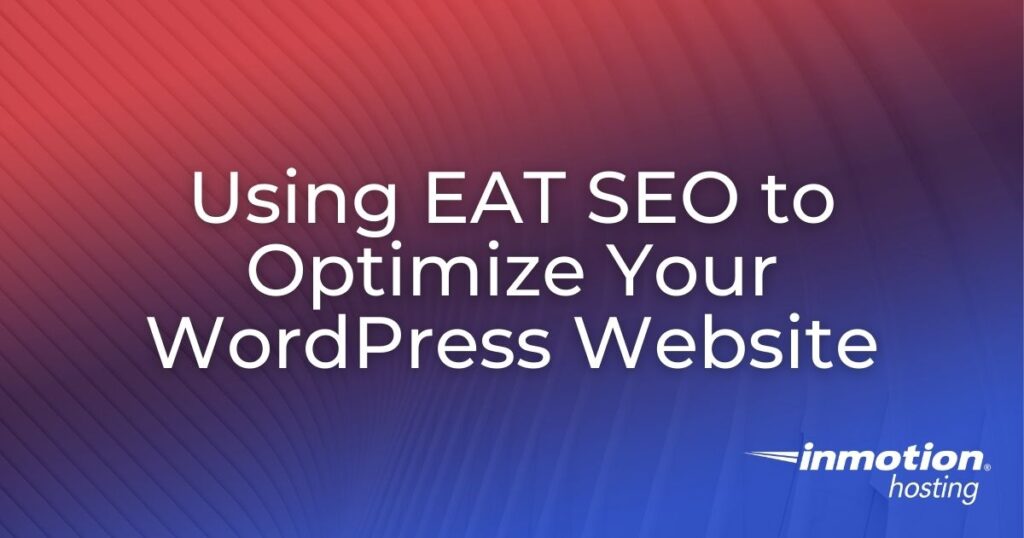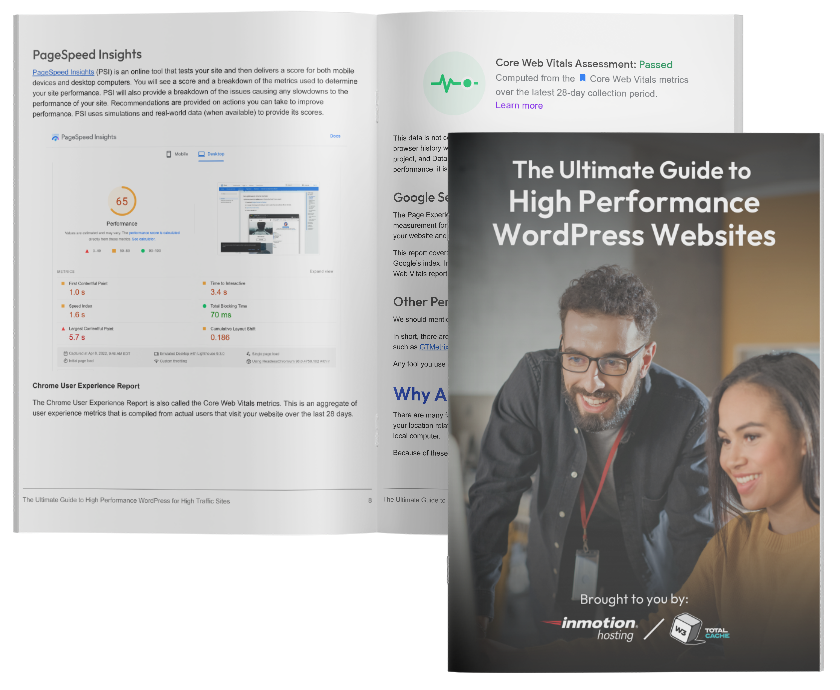
Welcome to the InMotion Hosting EAT SEO guide. In this article we will detail all the basics of what EAT SEO is and how you can use it to benefit your blog or business.
We will break down E-A-T, find out how EAT is applied to your website, as well as how to use it to optimize your WordPress website.
In this article:
- What is EAT SEO?
- Breaking Down E-A-T
- How is EAT Applied?
- Optimizing Your WordPress Website for EAT SEO
What is EAT SEO?
EAT SEO is an abbreviation for a set of factors Google uses to help determine the quality of web pages. It stands for Expertise, Authoritativeness, and Trustworthiness.
The acronym was first introduced in 2014 but became a part of Google’s Search Quality Evaluator official guidelines in 2018. The three factors combine to form a single factor within Google’s algorithm.
In short, Google’s EAT guidelines help establish whether or not users should trust you, your website or your content.
Understanding what EAT is and knowing how to use it to boost the quality of your site should be an integral part of any SEO strategy.
Breaking Down E-A-T
We know that EAT stands for Expertise, Authoritativeness, and Trustworthiness, but it’s important to know the definition of each word as it applies to Google’s algorithm.
- Expertise is how knowledgeable either you, the site owner or content author is on the topic or subject matter they are writing or talking about.
- Authoritativeness relates to the credibility of the website publishing the content.
- Trustworthiness examines how trustworthy your site or the site in question is. This factors in overall site quality, especially with things like website security.
How is EAT Applied?
One of the ways Google improves their search results is by using third-party Search Quality Raters. These raters are human, not machine, and they assess and give feedback on websites based on how helpful or unhelpful your site is to visitors, not to search engines.
Raters are spread all throughout the world but they all follow the same set of guidelines in order to determine a Page Quality (PQ) rating.
Google says that the first step of determining the PQ rating is to understand the true purpose of a page.
Section 3.0 of the guidelines states:
“Websites or pages that do not have any beneficial purpose, including pages that are created with no attempt to help users, or pages that potentially spread hate, cause harm, or misinform or deceive users, should receive the Lowest rating. No further assessment is necessary”
Section 3.2 continues:
“For all other pages that have a beneficial purpose, the amount of expertise, authoritativeness, and trustworthiness is very important.”
Raters are told to research the following items to begin determining an EAT score.
- Main Content (MC) Quality and Amount
- Website Information/information about who is responsible for the MC
- Website Reputation/reputation about who is responsible for the MC
They then assess how well the above items demonstrate:
- The expertise of the creator of the media content (MC).
- The authoritativeness of the creator of the MC, the MC itself, and the website.
- The trustworthiness of the creator of the MC, the MC itself, and the website.
Analysis and evaluation of all the above items is how raters determine an overall EAT score.
Now that you know how EAT is used and evaluated, let’s take a look at how you can use it to improve your site’s SEO.
Optimizing Your WordPress Website for EAT SEO
Optimizing your WordPress website for EAT SEO can take some time, but the effort you put in to doing so will go a long way in helping your SEO ranking.
Spend some time thinking about the topic of each page and asking yourself what kind of expertise is required for the page to achieve its purpose well. Google’s standard for expertise for each page depends on the topic of the page.
Below are several tips to help you improve your EAT stats.

Clearly Identify Your Website
Depending on if your website is a blog or a business, you should have either an About Us page or an About Me page. On these pages, you want to be sure to identify you or your company as the owner of your website.
On an About Us page, companies should provide some basic information about the business that will help identify it such as when the company was created, who started it, and what type of business it is.
For About Me pages, bloggers have an opportunity to tell their readers about their education and experience as it applies to their site’s content.
Of course, either page needs to also have essential information such as email address, mailing address and phone number.
Doing these things helps identify your site to Google.
Don’t Hide Your Authors
Once you’ve identified your WordPress website and site owners, the next step is to identify the authors of your website’s content.
Make sure that each post identifies who produced the content, and ensure that all authors have author bios to help establish background and credibility.
This includes linking to other published works they have such as relevant articles or books.
Your authors should also have social profiles. The more platforms they have an established presence on, the better.
If you have contributing authors, have them submit a short bio with their work for you to include in the post.
Write Good Content and Back it Up
Share and promote your expertise by writing great, relevant content. The more content you have that demonstrates your expertise and the further back it dates the better. Here are 13 great tips to get you started.
Additionally, be sure to provide sources for your information when you can. If you’re stating stats or figures, have the research or analysis to back it up.
Safety and Security
A good way to boost your EAT score is to ensure your website is safe and secure.
Make sure your site follows https protocol and enable https in WordPress so users can connect to your website securely using an SSL certificate.
It is also very important to publish all legal notices that are required by the country you do business in. Do some research so you know which legal notices are required by your country, as the requirements can differ from country to country. Some countries require eCommerce sites to have a return policy, while others a privacy policy or additional legal notices.
Collaborate with Relevant Sites
External sites can also help you improve your EAT score.
You will want to establish a link building strategy so you can make a practice of backlinking to relevant sites as well as work on getting relevant sites to backlink to you.
Check any backlinks to you and make sure they are working and not broken. You can do this using the Broken Link Checker.
Encourage Customer Reviews and Comments
Customer interaction can be a great way to boost your EAT score. Ask happy customers to leave reviews on your website as well as on relevant review sites.
You can also encourage comments on posts and reviews on products or services. Be careful though as this can come back to bite you if you open comments to anyone.
The good news is Google is usually able to tell the difference between actual content on a website and comments.
Claim your Name (or Business)
Another easy way to give your website an EAT boost is to claim your business anywhere there exists an opportunity to do so.
If you find a result for your name or business in the Google Knowledge panel when you search for your name in Google, make sure that you claim it. Likewise, you will want to claim your business on Google My Business, as well as any yellow pages services.
You should now know that E-A-T stands for Expertise, Authoritativeness, and Trustworthiness, and how EAT SEO is applied to your PQ ratings.
Google EAT SEO may not be the easiest thing to understand and apply right away, but with practice, there are several things you can do to help boost your site’s score.
We have covered several of the most popular ways to boost your EAT score. If you went through the list and realized you hadn’t done anything on it, you probably have some work to do.
If everything we covered was something you’ve already taken care of, chances are you have a decent EAT score.
That means it’s time to create even more content. Just keep EAT in mind while you do so.
For more SEO help, check out our SEO educational page.
Say goodbye to slow loading times and hello to high-performance websites with our new WordPress VPS Hosting plans. Experience 40x faster WordPress page load speeds on purpose-built servers that guarantee 99.99% uptime.
High-Performance VPS
Fully-Managed Support
Free SSL & Dedicated IP
Advanced Server Caching